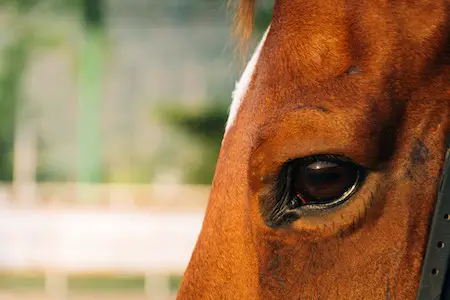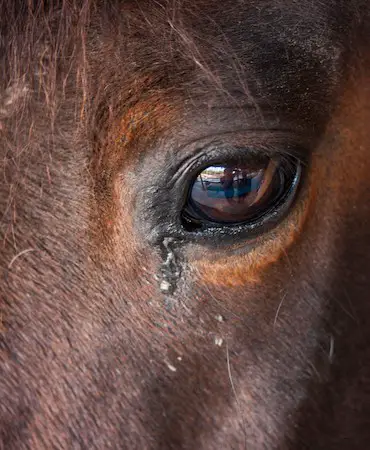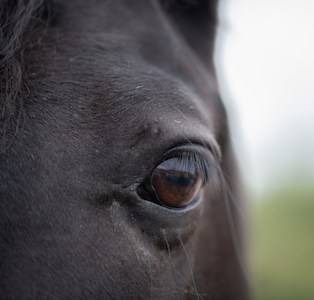Injuries are all part and parcel of sport. Some injuries can be minor whereas some may be very unsettling and may require surgical procedures and physiotherapy. In terms of horse racing, a horse’s eye is one of the most functional and aesthetically pleasing features so when an eye injury occurs, it can be unsettling for both the horse and the owner.
This article will focus on horse-eye infections and injuries that may occur on a horse, as well as outlining what to expect for treatment and recovery.
Corneal Ulcers
Before sharing the eye infections in a horse, Rachel Bourne, DVM, a practitioner at Wisconsin Equine Clinic & Hospital, in Oconomowoc, stated that “the horse’s eye is a beautiful structure that tells us so much about them. By looking at the eye, we can often tell how the horse is feeling, what they are thinking, and more. The eye is a window into the horse’s soul”.
This tells you everything you need to know about a horse.
As stated earlier, a horse’s eye is one of the most aesthetically pleasing features and it’s best to maintain a good relationship with the horse so that the horse can build a connection with the rider/owner and there would be no problems between them. In terms of injuries, the most common eye emergencies in horses are known as the ‘Corneal Ulcers‘.
This is a scratch on the surface of the eye caused by trauma. Horses can sustain these scratches when getting poked in the eye by a piece of grass, hay, or a twig. A Corneal ulcer is a very uncomfortable pain, accompanied by excessive tearing and a strong urge to keep the eye shut.
As the pain is uncomfortable, it is difficult for the owners to distinguish the extent of the scratch or what the injury even is in the first place, therefore, it is essential that a veterinarian is called up and is given a detailed description of the clinical signs and can deliver her professional opinion about diagnosis and treatment.

It is often said that in sport small injuries can eventually result in major complications if not dealt with at the right time. Leaving the corneal ulcer undiagnosed can lead to more serious problems such as bacterial and fungal infections. Before the veterinarian arrives, the horse must be placed with a fly mask to prevent sunlight, dirt, and insects from coming in contact with the ulcerated eye.
If the horse allows this, a veterinarian might also suggest applying a cold compress to provide pain relief.
Regarding a diagnosis, horses need to be sedated so that the veterinarian can get a better look at the eye and they may also choose to perform nerve blocks around the eye to counteract the horse’s instinct to hold it tightly.
In terms of treatment, antibiotics may be applied to prevent infection, accompanied by non-steroidal anti-inflammatories such as Flunixin meglumine (Banamine) to control the pain.
Recovery-wise, if the ulcer is minor, the horse is typically much better within 24 hours of starting treatment. In most cases, a healthy horse will heal completely in three to seven days.
Foreign Body Injuries
The foreign body can be floating across the eyeball, embedded in the lids or along the sides of the eye, or in a worst-case scenario, it impales the eye itself. It is very common for a foreign body to cause a corneal ulcer.
Most of the time, the clinical signs for a foreign body injury may not be seen due to excessive tearing and swelling. If a foreign body has impaled the eye, people may see it but, it should not be removed. Removing a foreign body can cause the structure of the eye to collapse and this is very serious and may result in eye loss.
Due to the clinical signs for many injuries, it is therefore important for a professional to diagnose a horse. It is important to prevent the horse from rubbing the eye as this can cause further damage. Similar to corneal ulcer treatment, veterinarians often sedate the horse and use nerve blocks around the eye so they can properly assess and locate the foreign body. Good and professional care must be provided for the horse to receive full treatment and recovery.
Recovery-wise, the healing time can vary greatly as this depends on both the object’s location and the injury’s severity. Signs of recovery may be apparent as soon as an object is removed and for more complicated cases, the recovery period can be as long as several months and require surgical procedures.
Eyelid Lacerations
Both the upper and lower eyelid can sustain lacerations or tears. Horses like to rub their heads on objects around them and this can include stall walls, fences, and bucket handles. An eyelid laceration is much easier for the owner to identify than a corneal ulcer as the owners would see an obvious defect of the upper or lower eyelid, accompanied by blood, pain, and swelling.

Eyelid lacerations, however, typically heal very well as there is a great amount of blood flow in the horse’s head.
A laceration in the eyelid area however can create an area of the cornea that is no longer covered if not properly stitched. So in such a case, the horse may not be able to protect the area of the eye when blinking, resulting in long-term damage and problems. As stated earlier, a horse’s eye is one of the most functional and aesthetically pleasing features and a form of injury to the eye can be difficult for the owner and the horse.
Treatment-wise, a veterinarian should suture any laceration within four-six hours. Suturing requires precise alignment and the use of very thin sutures, therefore, it is essential that plastic surgery is carried out to repair an eyelid and the owners can help by providing a well-lit space and a stack of shavings bales or other props, that can be used as a table to support the horse’s head during the repair.
After suturing, it’s all about providing the horse with the right medication and providing systemic antibiotics to prevent prevention and non-steroidal anti-inflammatories for pain. A fly mask would also be used to keep the wound clean and avoid insect irritation during healing. Recovery-wise, most uncomplicated lacerations heal well in 10 to 14 days and leave minimal scarring.
Orbital Fractures
These fractures to the bone surrounding the eye are caused by trauma, such as a kick by another horse. The clinical signs are mainly swelling, accompanied by a laceration and this is visible to the owners.
Most orbital fractures require some kind of advanced imaging such as Radiotherapy, Ultrasound, and computed tomography for diagnosis. Treatment wise, if the fracture is simple, anti-inflammatory pain medication may be given, however, if the fracture is more complex, surgery is often required to plate the complex or displaced fracture.
The main function of the orbit is to protect the eye, therefore, if a fracture occurs to the structure, it’s all about repairing it as close to its normal shape as possible, for both functional and aesthetic reasons.

Recovery-wise, any orbital fracture would roughly take around four to six months to heal completely. It is all about providing the right care from the right people, and in this case, the equine veterinarian is the one who provides the right treatment.
Once recovered, the horse can then typically ease back into work once the pain and swelling subside. This takes time. Horses must be provided with a good recovery session, a good diet, rest, and support from the owner and the veterinarians so that horses can recover in time for upcoming equestrian events.
Final Thoughts
In conclusion, many eye injuries cause the same clinical signs therefore, most owners cannot distinguish the difference between an allergic reaction, bee sting, acute uveitis flare-up, corneal ulcer, and plenty more.
Different injuries require different treatment and different recovery periods, therefore, it is essential that a professional carry out the treatments to a horse and that the work is done to an appropriate and professional standard to prevent infection and further damage. This is the main priority.
With appropriate care and support, horses can then participate in equestrian events and maintain a good relationship with the owner/rider.

